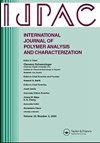灰葫芦(Benincasa Hispida)果皮颗粒填充环氧树脂复合材料的力学、热学和吸水性能
IF 1.6
4区 工程技术
Q4 POLYMER SCIENCE
International Journal of Polymer Analysis and Characterization
Pub Date : 2024-10-02
DOI:10.1080/1023666X.2024.2378890
引用次数: 0
摘要
最近,生物复合材料因其在各行各业的潜在应用而备受关注。其最显著的优点是成本低、可生物降解、重量轻、可用性强,并能解决环境问题。本研究利用食物垃圾灰葫芦(Benincasa hispida)皮作为填充材料,生产环氧树脂(EP)复合材料。研究了灰瓜皮颗粒百分比(0 至 25 wt.%)对所开发复合材料机械性能、热性能和吸水性能的影响。当灰瓜皮在复合材料中的重量百分比为 5%时,复合材料的最大拉伸强度、弯曲强度和邵氏 D 硬度分别为 47.52 兆帕、2409.17 兆帕和 79.6。据观察,环氧基体中高浓度的灰瓜皮颗粒会对制造的生物复合材料的机械特性产生负面影响。此外,增加灰瓜皮颗粒的比例会增加复合材料在蒸馏水、海水和自来水中的吸水性。按重量计含有 5%填料的复合材料在浸入海水时的吸水率极低。为研究新开发的复合材料的热行为,进行了热重分析。此外,还利用扫描电子显微镜对断裂表面进行了形态学检查。这项研究提出了灰瓜皮颗粒作为复合材料填料的潜在替代品。本文章由计算机程序翻译,如有差异,请以英文原文为准。
Mechanical, Thermal, and Water Absorption Behavior of Ash Gourd (Benincasa Hispida) Peel Particles Filled Epoxy Composites
Recently, bio-composites have attracted much attention due to their potential applications in various industries. The most notable benefits are the product’s low cost, biodegradability, lightweight, availability, and ability to solve environmental issues. The present research utilizes ash gourd (Benincasa hispida) peel, a food waste, as a filler material to produce epoxy (EP) composites. The effect of ash gourd peel particle percentage (ranging from 0 to 25 wt.%) was studied on the developed composites’ mechanical and thermal properties and water absorption behavior. The maximum tensile strength, flexural strength, and shore D hardness were 47.52 MPa, 2409.17 MPa, and 79.6respectively, when the ash gourd peel was 5% by weight in the composite. It was observed that the mechanical characteristics of manufactured bio-composites are negatively affected by the high concentration of ash gourd peel particles in the epoxy matrix. Also, increasing ash gourd peel particle fraction increases the water absorption of composites when immersed in distilled, sea, and tap water. The composite with 5% filler by weight absorbs water at a minimal rate when immersed in seawater. Thermogravimetric analysis was conducted to investigate the newly developed composite’s thermal behavior. In addition, a morphological examination of the fractured surfaces was carried out with assistance from a scanning electron microscope. The work presents ash gourd peel particles as the potential alternative to be used as filler in composites.
求助全文
通过发布文献求助,成功后即可免费获取论文全文。
去求助
来源期刊
CiteScore
3.50
自引率
5.30%
发文量
37
审稿时长
1.6 months
期刊介绍:
The scope of the journal is to publish original contributions and reviews on studies, methodologies, instrumentation, and applications involving the analysis and characterization of polymers and polymeric-based materials, including synthetic polymers, blends, composites, fibers, coatings, supramolecular structures, polysaccharides, and biopolymers. The Journal will accept papers and review articles on the following topics and research areas involving fundamental and applied studies of polymer analysis and characterization:
Characterization and analysis of new and existing polymers and polymeric-based materials.
Design and evaluation of analytical instrumentation and physical testing equipment.
Determination of molecular weight, size, conformation, branching, cross-linking, chemical structure, and sequence distribution.
Using separation, spectroscopic, and scattering techniques.
Surface characterization of polymeric materials.
Measurement of solution and bulk properties and behavior of polymers.
Studies involving structure-property-processing relationships, and polymer aging.
Analysis of oligomeric materials.
Analysis of polymer additives and decomposition products.

 求助内容:
求助内容: 应助结果提醒方式:
应助结果提醒方式:


